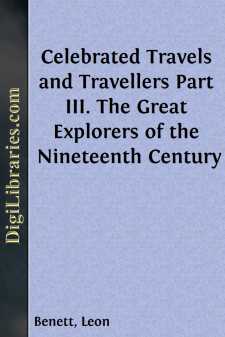Categories
- Antiques & Collectibles 13
- Architecture 36
- Art 48
- Bibles 22
- Biography & Autobiography 813
- Body, Mind & Spirit 142
- Business & Economics 28
- Children's Books 14
- Children's Fiction 11
- Computers 4
- Cooking 94
- Crafts & Hobbies 4
- Drama 346
- Education 46
- Family & Relationships 57
- Fiction 11829
- Games 19
- Gardening 17
- Health & Fitness 34
- History 1377
- House & Home 1
- Humor 147
- Juvenile Fiction 1873
- Juvenile Nonfiction 202
- Language Arts & Disciplines 88
- Law 16
- Literary Collections 686
- Literary Criticism 179
- Mathematics 13
- Medical 41
- Music 40
- Nature 179
- Non-Classifiable 1768
- Performing Arts 7
- Periodicals 1453
- Philosophy 64
- Photography 2
- Poetry 896
- Political Science 203
- Psychology 42
- Reference 154
- Religion 513
- Science 126
- Self-Help 84
- Social Science 81
- Sports & Recreation 34
- Study Aids 3
- Technology & Engineering 59
- Transportation 23
- Travel 463
- True Crime 29
Celebrated Travels and Travellers Part 2. The Great Navigators of the Eighteenth Century
by: Leon Benett
Categories:
Description:
Excerpt
CHAPTER I.
I.C.Cassini—Picard and La Hire—The arc of the Meridian and the Map of France—G. Delisle and D'Anville—The Shape of the Earth—Maupertuis in Lapland—Condamine at the Equator.
Before we enter upon a recital of the great expeditions of the eighteenth century, we shall do well to chronicle the immense progress made during that period by the sciences. They rectified a crowd of prejudices and established a solid basis for the labours of astronomers and geographers. If we refer them solely to the matter before us, they radically modified cartography, and ensured for navigation a security hitherto unknown.
Although Galileo had observed the eclipses of Jupiter's satellites as early as 1610, his important discovery had been rendered useless by the indifference of Governments, the inadequacy of instruments, and the mistakes committed by his followers.
In 1660 Jean Dominique Cassini published his "Tables of the Satellites of Jupiter," which induced Colbert to send for him the following year, and which obtained for him the superintendence of the Paris Observatory.
In the month of July, 1671, Philippe de la Hire went to Uraniborg in the Island of Huen, to take observations for the situation of Tycho Brahe's Observatory. In that spot he calculated with the assistance of Cassini's Tables, and with an exactitude never before obtained, the difference between the longitudes of Paris and Uraniborg.
The Academy of Sciences sent the astronomer Jean Richter the same year to Cayenne, to study the parallaxes of the sun and moon, and to determine the distance of Mars and Venus from the earth. This voyage, which was entirely successful, was attended with unforeseen consequences, and resulted in inquiries shortly after entered into as to the shape of the earth.
Richter noticed that the pendulum lost two minutes, twenty-eight seconds at Cayenne, which proved that the momentum was less at this place than at Paris. From this fact, Newton and Huyghens deduced the flatness of the Globe at the Poles. Shortly afterwards, however, the computation of a terrestrial degree given by Abbé Picard, and the determination of the Meridional arc, arrived at by the Cassinis, father and son, led scientific men to an entirety different result, and induced them to consider the earth an elliptical figure, elongated towards the polar regions. Passionate discussions arose from this decision, and in them originated immense undertakings, from which astronomical and mathematical geography profited.
Picard undertook to estimate the space contained between the parallels of Amiens and Malvoisine, which comprises a degree and a third. The Academy, however, decided that a more exact result could be obtained by the calculation of a greater distance, and determined to portion out the entire length of France, from north to south, in degrees. For this purpose, they selected the meridian line which passes the Paris Observatory. This gigantic trigonometrical undertaking was commenced twenty years before the end of the seventeenth century, was interrupted, and recommenced, and finally finished towards 1720....




